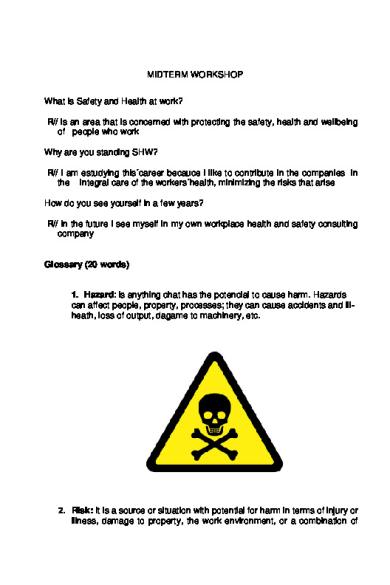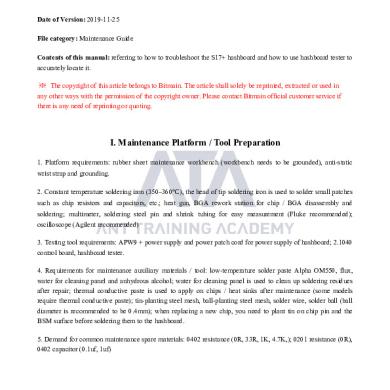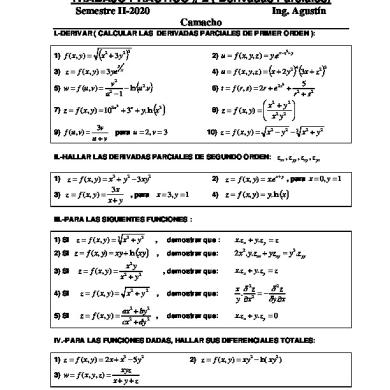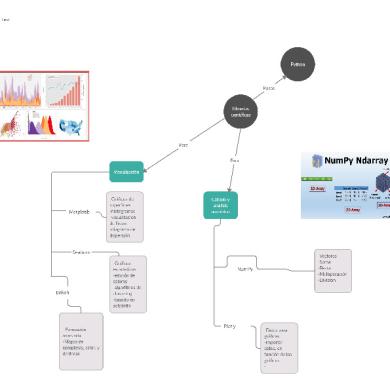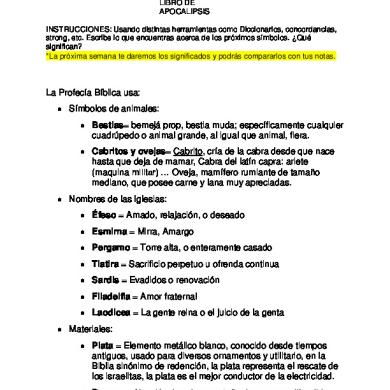* The preview only shows a few pages of manuals at random. You can get the complete content by filling out the form below.
Description
MIDTERM WORKSHOP What is Safety and Health at work? R// is an area that is concerned with protecting the safety, health and wellbeing of people who work Why are you standing SHW? R// l am estudying this´career becauce l like to contribute in the companies in the integral care of the workers´health, minimizing the risks that arise How do you see yourself in a few years? R// in the future l see myself in my own workplace health and safety consulting company
Glossary (20 words)
1. Hazard: is anything chat has the potencial to cause harm. Hazards can affect people, property, processes; they can cause accidents and illheath, loss of output, dagame to machinery, etc.
2. Risk: It is a source or situation with potential for harm in terms of injury or illness, damage to property, the work environment, or a combination of
these.
3. work accident: It is any sudden event that occurs due to or on the occasion of work and that causes an organic injury, a functional disturbance, a disability or death in the worker. Also, it is one that occurs during the execution of the employer's orders, or during the execution of a work under his authority, even outside the place and working hours.
4 Threat: Technical, natural or social factors capable of disturbing the physical integrity of people or causing damage to the environment.
5 Absenteeism: days lost from work. Even the hours of absence from work added together are also considered absenteeism.
6 Diagnosis: Qualification of a disease according to symptoms
7 Emergency: Situation that implies a state of partial or total disturbance caused by the occurrence of an unwanted event.
8 personal protection equipment: It is an element designed to prevent people who are exposed to a particular danger from coming into direct contact with it. Protective equipment prevents contact with the hazard but does not eliminate
9 Ergonomics: studies the wide variety of problems that arise in the mutual adaptation between man and machine and their environment, seeking productive efficiency and well-being of work.
10 Evacuation: Action aimed at establishing a barrier or distance between a source of risk and threatened people, up to and through places of lower risk.
11 Risk factor: It is understood under this denomination, the existence of elements, phenomena, conditions, circumstances and human actions, which contain a potential capacity to cause injury or damage and whose probability of occurrence depends on the elimination or control of the aggressive element.
12 Industrial hygiene: It comprises the set of activities aimed at the identification, evaluation and control of the agents and factors of the work environment that may affect the health of workers.
13 Temporary disability: It is when due to an accident, the worker must be absent from work for a period of time greater than one day. During the duration of the disability, the member received a subsidy equivalent to 100% of their base contribution salary
14 Law: Mandatory norm issued by the legislative power - Congress of the Republic
.
15 Work Medicine: It is the set of medical and paramedical activities aimed at promoting and improving the health of the worker, evaluating their work capacity and placing them in a workplace according to their psychobiological conditions.
16 Morbidity: It refers to the percentage of patients in relation to a specific population.
17 Occupations or trades: Codes assigned in the Professional Loss System.
18 Active breaks: It consists of the use of various techniques in short periods (Maximum 10 minutes), during the working day in order to activate breathing, blood circulation and body energy to prevent psychophysical disorders caused by physical and mental fatigue and enhance functioning brain increasing productivity and work performance.
19 Security policy: An important requirement within a quality and safety management system is compliance with basic legislation on occupational health and a commitment to continuously improve the health and safety conditions of workers.
20 Compensation: Single value paid to the worker who, as a result of an AT or an EL, reduces his work capacity by a percentage greater than 5% and less than 50%
